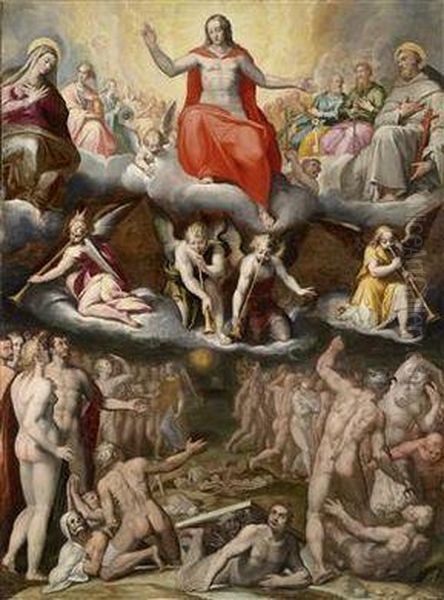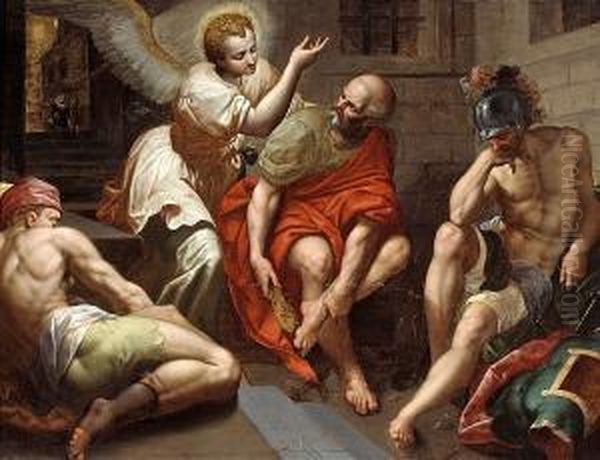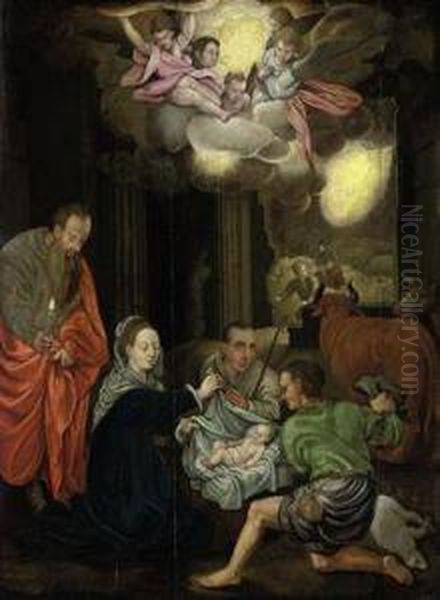Jacob de Backer stands as a fascinating, albeit somewhat enigmatic, figure in the rich tapestry of 16th-century Flemish art. Active in Antwerp during a period of immense artistic ferment and socio-political upheaval, De Backer produced a significant body of work characterized by its sophisticated Mannerist style, complex allegorical themes, and a palpable engagement with Italian Renaissance ideals. Despite a tragically short career, his paintings and designs for prints left an indelible mark, influencing contemporaries and providing later art historians with a compelling case study of artistic transmission and workshop practices in the Southern Netherlands. His life, though poorly documented, and his art, though sometimes debated in attribution, reveal an artist of considerable talent and intellectual depth.
The Shadows of a Biography: Early Life and Formation
The precise details of Jacob de Backer's life remain shrouded in a degree of uncertainty, a common challenge when studying artists from this period for whom comprehensive archival records are scarce. He is believed to have been born in Antwerp, a bustling cosmopolitan port city and a leading center for art production in Northern Europe. The estimated period of his birth is around 1555, though some sources suggest a slightly later date. His death, reportedly at the young age of approximately 30, is placed by scholars sometime between 1585 and 1591, or perhaps even as late as 1600. This premature demise undoubtedly curtailed a promising career.
According to the early art historian Karel van Mander, writing in his Schilder-boeck (Book of Painters) of 1604, De Backer's early life was marked by hardship. Van Mander recounts that the young Jacob was abandoned by his father, also a painter, who left for Italy and never returned. This narrative, if accurate, paints a poignant picture of his formative years.

His artistic training is somewhat clearer. He is recorded as having initially studied with Antonio van Palmo (c. 1515–1589), a painter and art dealer in Antwerp. Van Palmo's studio would have provided De Backer with foundational skills and exposure to the artistic trends of the day. Subsequently, De Backer is said to have entered the workshop of Hendrick van Steenwijk the Elder (c. 1550–1603), a painter renowned for his architectural perspectives, particularly church interiors. While De Backer's own oeuvre doesn't heavily feature architectural painting, his time with Van Steenwijk would have honed his understanding of perspective and spatial composition, skills evident in his complex figural arrangements.
Interestingly, there is no definitive record of Jacob de Backer being registered as an independent master in the Antwerp Guild of Saint Luke, the city's powerful artists' guild. This omission is unusual for a painter of his apparent productivity and standing, and has fueled speculation about his working methods and status, possibly suggesting he operated primarily within larger workshop structures or under the aegis of other masters or dealers for a significant portion of his career.
The Allure of Italy: Style and Influences
Jacob de Backer's artistic style is firmly rooted in Mannerism, the dominant European artistic movement of the mid-to-late 16th century that followed the High Renaissance. Mannerism is characterized by its elegance, artificiality, elongated human figures, exaggerated poses (often involving figura serpentinata – a serpentine, twisting pose), complex compositions, and a penchant for intellectual or esoteric subject matter. De Backer's work embodies many of these traits.
A defining characteristic of De Backer's art is its profound debt to Italian Renaissance and Mannerist models. His figures often display the muscularity and anatomical understanding reminiscent of Michelangelo, combined with the grace and elongated proportions favored by artists like Parmigianino or Bronzino. The influence of Roman and Florentine Mannerism, particularly the sophisticated and often courtly style of Giorgio Vasari and his circle, is palpable. Vasari, himself an artist, architect, and the foundational art historian, championed a style that emphasized disegno (design or drawing) and intellectual conceit, elements clearly valued by De Backer.
The elegant, sometimes melancholic, beauty of his female figures and the sophisticated handling of drapery also suggest an awareness of Venetian masters like Titian and Veronese, known for their rich colorism and sensuous forms. The influence of Giorgione, particularly his enigmatic and poetic approach to subject matter, is also cited by scholars as a potential source of inspiration for De Backer's refined aesthetic.

Whether De Backer ever traveled to Italy himself is a subject of ongoing debate among art historians. Karel van Mander does not mention such a journey. If he did not undertake the Italian sojourn common for ambitious Northern European artists of his time (like his contemporaries Maerten de Vos or Otto van Veen), he would have absorbed these Italianate influences through other means. Antwerp, as a major international trading and printing hub, was awash with Italian prints, drawings, and even paintings. Engravings by artists like Marcantonio Raimondi, who disseminated Raphael's designs, or prints after Michelangelo, Giulio Romano, and other Italian masters, circulated widely and provided a rich visual vocabulary for artists like De Backer. He may also have learned from Flemish artists who had returned from Italy, such as Frans Floris, whose Romanist style had a transformative impact on Antwerp painting a generation earlier.
Despite the strong Italianate flavor, De Backer's work retains certain Northern characteristics. There is often a meticulous attention to detail, a richness of texture, and a narrative clarity that aligns with Flemish traditions. His synthesis of these transalpine influences with local artistic conventions resulted in a distinctive and highly accomplished Mannerist idiom.
Themes and Iconography: A World of Allegory and Erudition
Jacob de Backer's thematic repertoire was diverse, encompassing religious scenes, mythological narratives, and, most notably, complex allegories. His choice of subjects often suggests a high degree of erudition and an engagement with the humanist intellectual currents of the era.
Religious subjects formed a significant part of his output. He painted scenes from both the Old and New Testaments, often imbuing them with dramatic intensity and emotional depth. His depictions of the Last Judgment, for instance, are powerful and dynamic, filled with writhing figures and a clear articulation of divine justice. These compositions demonstrate his ability to manage large numbers of figures in complex, multi-tiered arrangements, a hallmark of ambitious history painting.
Mythological themes, drawn from classical antiquity, also feature in his work. These subjects provided opportunities for depicting the nude figure, showcasing anatomical knowledge and exploring narratives of love, conflict, and transformation that were popular during the Renaissance and Mannerist periods. Artists like Ovid were common sources.
However, De Backer is perhaps best known for his allegorical paintings, particularly series such as The Seven Deadly Sins. These works personify abstract concepts, often drawing on established iconographic traditions but reinterpreting them with a fresh and sophisticated visual language. Such allegories were highly valued for their intellectual content, inviting viewers to decipher their meanings and reflect on moral or philosophical ideas. His Allegory of Peace and Justice is another example of this genre, conveying complex ideas through symbolic figures and attributes. The intricate interplay of figures and symbols in these works underscores the intellectual climate of Antwerp, where patrons often appreciated art that engaged the mind as well as the eye.
Masterpieces and Attributions: A Closer Look at Key Works
Despite the uncertainties surrounding his life, a substantial body of work is attributed to Jacob de Backer, either as autograph works or products of his workshop.

The Last Judgment: Several versions of The Last Judgment are associated with De Backer, showcasing his mastery of large-scale, multi-figure compositions. Two notable examples were created as epitaph paintings. One, for Pieter Goetkin I, is housed in the Cathedral of Our Lady, Antwerp. Another, for the renowned printer-publisher Christophe Plantin, is in the collection of the Royal Museum of Fine Arts Antwerp. These works are characterized by their dynamic energy, with Christ enthroned as judge, surrounded by saints and angels, while the resurrected souls are separated into the blessed ascending to heaven and the damned cast into hell. The muscular, often contorted, figures reveal a clear debt to Michelangelo's famous fresco in the Sistine Chapel, likely known through prints.
The Seven Deadly Sins: This series is perhaps De Backer's most famous and widely discussed group of works. Each painting personifies one of the cardinal sins – Pride, Envy, Wrath, Sloth, Greed, Gluttony, and Lust – through intricate allegorical scenes. These compositions are rich in symbolism and demonstrate De Backer's inventive approach to traditional iconography. The figures are typically elegant and elongated, set within dynamic and sometimes crowded scenes. This series was notably acquired by Cosimo Masi, secretary to Alessandro Farnese, Duke of Parma, and was sent to Parma in 1594. It eventually found its way to the Museo di Capodimonte in Naples, where it remains a highlight. The international appeal of such a series speaks to the widespread taste for sophisticated allegorical art.
The Liberation of Saint Peter: This painting, now in the Musée des Beaux-Arts d'Orléans, depicts the biblical scene of an angel miraculously freeing Saint Peter from prison. Once attributed to Otto van Veen, it is now generally accepted as a work by De Backer. The composition, with its dramatic lighting and expressive figures, showcases his narrative skill and his ability to convey spiritual intensity. The influence of Raphael's treatment of the same subject in the Vatican Stanze may be discernible.
Allegory of Peace and Justice (Allegoria della Pace e della Giustizia): This work exemplifies De Backer's skill in the allegorical genre. Such paintings often carried political or social connotations, celebrating virtues essential for a well-ordered society. The personifications of Peace and Justice would have been readily understood by contemporary viewers familiar with Cesare Ripa's Iconologia, a popular emblem book that codified such allegorical figures.
Other works attributed to De Backer include various depictions of the Madonna and Child, The Holy Trinity, and scenes with saints, such as The Virgin and Child with Saints. The quality and style of these works can vary, leading to ongoing scholarly discussion about the extent of De Backer's personal involvement versus that of workshop assistants.
The Workshop Question: Collaboration and Production
The sheer volume of works attributed to Jacob de Backer, coupled with his short lifespan, strongly suggests the operation of an active workshop. In 16th-century Antwerp, it was common practice for successful masters to employ assistants and apprentices who would help with various stages of painting production, from preparing panels and grinding pigments to painting backgrounds, drapery, or even entire figures in the master's style. Artists like Frans Floris, Pieter Brueghel the Elder, and Maerten de Vos all ran substantial workshops to meet demand.
This workshop system complicates questions of attribution. It can be difficult to distinguish between a work entirely by the master's hand, a work executed with significant studio assistance, or a high-quality workshop replica of a successful composition. Some scholars have proposed that De Backer might have been more of a brilliant designer and head of a productive studio rather than executing every attributed piece himself. The variations in quality observed across the De Backer corpus lend credence to this idea. His designs, characterized by their elegance and complexity, could have been effectively translated by skilled assistants.
The lack of his formal registration as an independent master in the Guild of St. Luke might also tie into this. He could have worked for extended periods under contract to other masters or dealers, like his former teacher Antonio van Palmo, who was also an art dealer. In such a scenario, De Backer might have supplied designs or paintings that were then marketed under the dealer's name or as anonymous "Antwerp Mannerist" works.
De Backer in the Antwerp Art Scene: Contemporaries and Context
Jacob de Backer operated within the vibrant and competitive art world of late 16th-century Antwerp. The city was a crucible of artistic innovation, attracting talent from across the Low Countries and beyond. He was a contemporary of several significant Flemish painters.
Maerten de Vos (c. 1532–1603) was one of the leading figures, a prolific artist who, like De Backer, successfully blended Italianate influences with Northern traditions. De Vos also ran a large workshop and produced a vast number of paintings and designs for prints. Ambrosius Francken I (1544–1618) and his brother Hieronymus Francken I (1540–1610) were part of an extensive family of painters, known for their elegant Mannerist works, often with religious or allegorical themes. Marten van Cleve (c. 1527–c. 1581) specialized more in genre scenes, but his workshop also produced religious paintings in a Mannerist vein.
The generation preceding De Backer, including artists like Frans Floris (c. 1519–1570), had firmly established Romanism – the adoption of Italian Renaissance models – in Antwerp. Floris's impact was immense, and his large-scale, muscular figures set a precedent that De Backer and his contemporaries continued to engage with. Pieter Aertsen (c. 1508–1575) and Joachim Beuckelaer (c. 1533–c. 1575), while known for their pioneering market and kitchen scenes, also produced religious works that reflected prevailing stylistic trends.
The slightly younger generation, including Otto van Veen (c. 1556–1629), who would become Peter Paul Rubens's teacher, began to move towards a more classicizing style that prefigured the Baroque. De Backer's Mannerism, therefore, represents a specific moment in this stylistic evolution, a sophisticated and somewhat rarefied aesthetic that flourished before the dynamism and drama of the Baroque took hold.
The intellectual environment of Antwerp, fostered by institutions like the Plantin-Moretus Press (run by Christophe Plantin, one of De Backer's patrons), also played a crucial role. This press was a center of humanist scholarship and produced beautifully illustrated books, contributing to a culture that valued learning and sophisticated imagery. De Backer's allegorical works would have found a receptive audience in this milieu.
Dispersal and Recognition: Provenance and Auction History
Works by Jacob de Backer and his studio found their way into collections across Europe, attesting to their contemporary appeal. The Seven Deadly Sins series, as mentioned, traveled to Italy early on, entering the prestigious Farnese collection. This indicates that his reputation, or at least the desirability of his works, extended beyond the Low Countries.
Today, paintings attributed to De Backer are held in numerous public and private collections. Besides the Royal Museum of Fine Arts Antwerp, the Cathedral of Our Lady in Antwerp, and the Museo di Capodimonte in Naples, his works can be found in institutions such as the Musée des Beaux-Arts d'Orléans and various other European and American museums.
In the art market, works by Jacob de Backer continue to appear at auction. The epitaph of Pieter Goetkin I, The Last Judgment, was sold at Christie's New York in 2015 for a significant sum ($269,000), highlighting the continued appreciation for his major works. His Allegory of Peace and Justice has also appeared at Christie's. Other paintings attributed to him or his workshop are periodically offered by auction houses like Ketterer Kunst and others specializing in Old Master paintings. The prices can vary considerably depending on the quality, condition, subject matter, and certainty of attribution.
Legacy and Art Historical Assessment: A Fleeting Brilliance
Jacob de Backer's early death undoubtedly limited his long-term impact compared to artists with longer, more documented careers. He did not establish a large school of followers in the same way as masters like Frans Floris or later, Peter Paul Rubens. However, his contribution to Antwerp Mannerism is undeniable. He was a highly skilled practitioner of this international style, adapting Italianate forms and ideas with considerable sophistication and creating works of intellectual depth and visual appeal.
His paintings, particularly the allegorical series, demonstrate a refined sensibility and a mastery of complex composition. He stands as an important representative of the generation of Flemish artists working in the late 16th century, a period that bridged the gap between the earlier Romanists and the emergence of the Baroque. His work reflects the cosmopolitanism of Antwerp and its role as a conduit for artistic ideas flowing between Italy and Northern Europe.
Art historians continue to study De Backer to better understand the workings of Antwerp studios, the processes of artistic influence and adaptation, and the nuances of Mannerist aesthetics in the North. The ongoing debates surrounding attribution and the precise extent of his oeuvre are themselves indicative of an artist whose work remains compelling and worthy of scholarly attention. He serves as a reminder that significant artistic talent could flourish even within a relatively short and somewhat obscure career, leaving behind a legacy that continues to intrigue and impress.
Conclusion: An Enduring Enigma
Jacob de Backer remains a figure of captivating paradox: an artist whose name is not as widely known as some of his contemporaries, yet whose attributed works are numerous and often of high quality. He was a master of a sophisticated, internationally-inflected Mannerist style, creating complex allegories and powerful religious scenes that resonated with the intellectual and artistic tastes of his time. Born in Antwerp, trained by local masters, and profoundly influenced by Italian art (whether experienced directly or indirectly), he forged a distinctive artistic identity.
His short life and the lack of extensive documentation mean that many aspects of his career remain open to interpretation. The role of his workshop, the precise chronology of his works, and even the full extent of his travels are subjects of ongoing scholarly inquiry. Yet, through the paintings themselves – with their elegant figures, dynamic compositions, and rich symbolism – Jacob de Backer speaks to us across the centuries. He stands as a testament to the artistic vitality of 16th-century Antwerp and as a key exponent of Flemish Mannerism, an artist whose fleeting brilliance left a lasting impression on the art of the Southern Netherlands.